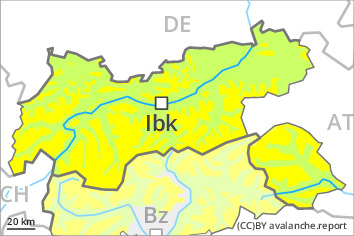
Danger level
 | 2200m |
|  |
|  |

Weakly bonded old snow above approximately 2200 m.
The backcountry touring conditions are mostly favourable.
Weak layers in the old snowpack can still be released in some places by individual winter sport participants, especially at transitions from a shallow to a deep snowpack, when entering gullies and bowls for example, as well as in little used backcountry terrain. The avalanche prone locations are rare but are difficult to recognise. Mostly avalanches are medium-sized.
On extremely steep sunny slopes individual wet avalanches are possible as the day progresses, but they will be mostly small. In the event of solar radiation this applies.
Snowpack
dp.1: deep persistent weak layer
dp.7: snow-poor zones in snow-rich surrounding
The weather conditions brought about a slow strengthening of the old snowpack.
Faceted weak layers exist in the snowpack, especially on shady slopes above approximately 2200 m, and on sunny slopes at elevated altitudes. The snowpack will be subject to considerable local variations above the tree line.
Outgoing longwave radiation during the night was reduced in some cases. The high humditiy will give rise to moistening of the snowpack at low and intermediate altitudes. In these altitude zones only a small amount of snow is lying for the time of year.
Tendency
Saturday: Slight increase in danger of wet avalanches in the course of the day.
